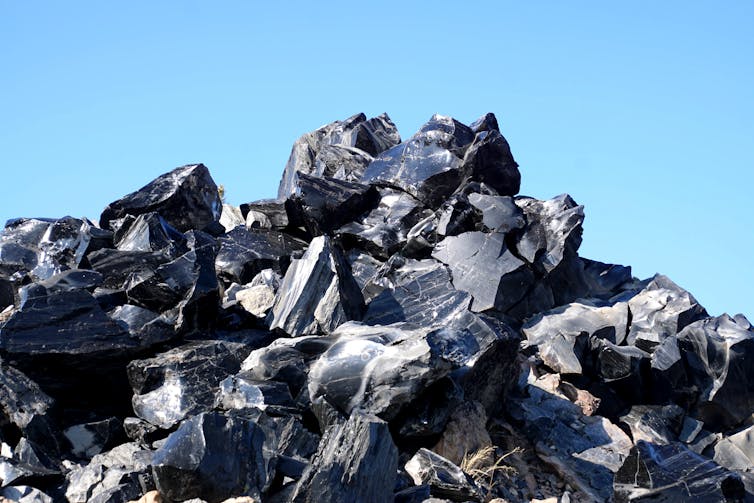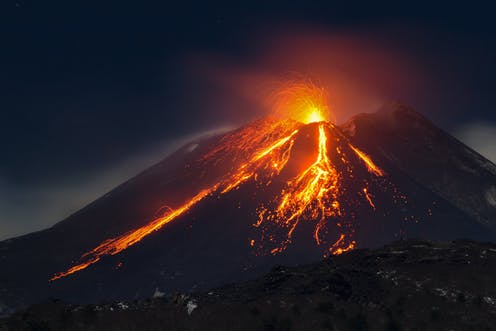How can we tell when a volcano is going to erupt? – Lena, aged eight, Frankfurt, Germany
Predicting when a volcano might erupt is very difficult. Some volcanoes erupt almost constantly, such as Kīlauea on Hawaii, but others may have gaps of hundreds of thousands of years between eruptions.
But we are much better at prediction now than we were 20 years ago, thanks to new or better developed techniques.
Firstly, it’s very important to know how each volcano has acted in the past, as each behaves differently. Scientists called volcanologists work this out by looking at the materials that have erupted from the volcano in the past.
If a volcano erupted gently, it would create lava flows, which are streams of molten rock. These cool and solidify to form sheets of hard rock. Other volcanoes create explosions when they erupt. These explosions produce fragments of rocks, crystals and volcanic glass (molten rock that has cooled very quickly at the surface).

steve estvanik/Shutterstock
Studying these materials can help volcanologists understand how violent the eruptions were, and how often the volcanoes explode.
Volcanologists can predict if a volcano is about to erupt by using several techniques. The surface of the volcano may get hotter, as the magma – the molten rock underground that pours out as lava when a volcano erupts – moves closer to the surface before an eruption. This can be monitored by detectors on satellites that measure heat.
Looking from space
The surface of the volcano may also be lifted up or dropped down due to movement of magma beneath the surface. This can be detected on the ground, but can also be measured from space by satellites using radar.
Radar detection of volcano movement works by studying any changes in the time taken to bounce radio waves from the satellite to the volcano and back again. The time will be shorter if the volcano has been lifted up.
Monitoring volcanoes from space is now very common. It is safer and less expensive than having volcanologists on the ground near the volcano being studied, particularly if it is erupting or in a very remote area.

Yvonne Baur/Shutterstock
Another way of finding out when a volcano is about to erupt is by measuring the gases escaping from it. This is because when magma moves towards the surface, gas escapes and rushes out ahead of the magma. These gases can be measured from space or on the ground. If the mixture of gases coming from the volcano changes, this may indicate that the magma below is moving.
Moving magma
Volcanologists also commonly use two other methods to see if a volcano is about to blow. When magma moves it shakes the land, creating a type of earthquake called a harmonic tremor. These tremors can indicate how fast and where the magma is moving.
A second method that can detect magma movement is gravity measurement. Gravity is, of course, the force that stops everything flying off the surface of the Earth into space. But the strength of that force actually decreases slightly if the surface beneath your feet becomes less dense.

Curious Kids is a series by The Conversation that gives children the chance to have their questions about the world answered by experts. If you have a question you’d like an expert to answer, send it to [email protected]. We won’t be able to answer every question, but we’ll do our very best.
This doesn’t mean you will suddenly fly into orbit, as the changes are tiny, but they can be measured by instruments called gravimeters. Molten rock has a lower density than when it is solid, so areas of lower gravity on a volcano, particularly if they change over time, might indicate magma – and the possibility of an eruption.
By studying a volcano’s past history and combining information from many different ground and space techniques, we can be reasonably confident that we will get it right and be able to issue warnings in good time to the people that live nearby, before the volcano erupts.
When sending in questions to Curious Kids, make sure you include the asker’s first name, age and town or city. You can:
- email [email protected]
- tweet us @ConversationUK with #curiouskids
- DM us on Instagram @theconversationdotcom
![]()
Ian Skilling does not work for, consult, own shares in or receive funding from any company or organisation that would benefit from this article, and has disclosed no relevant affiliations beyond their academic appointment.











